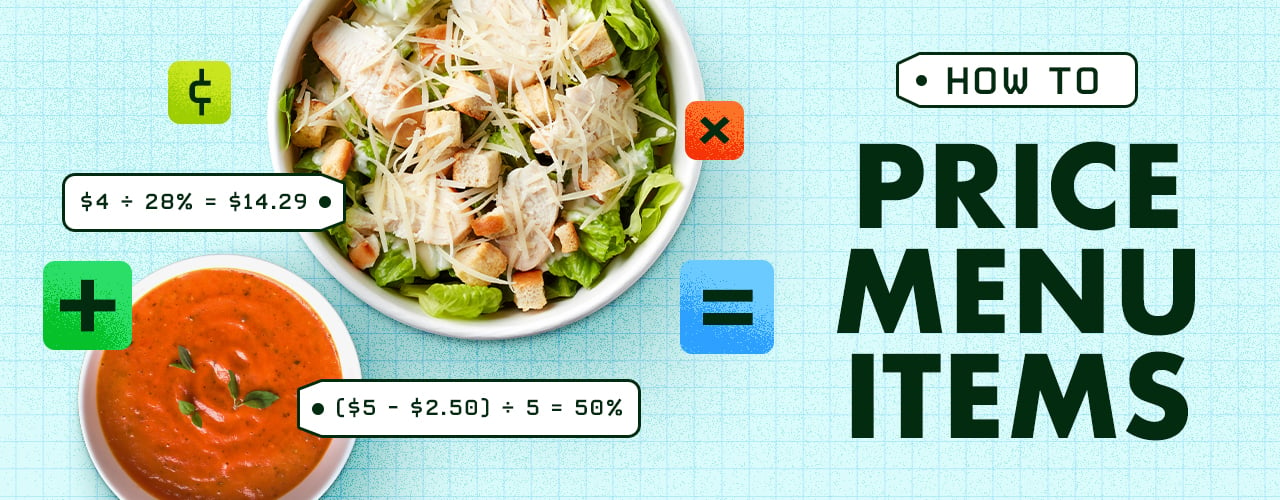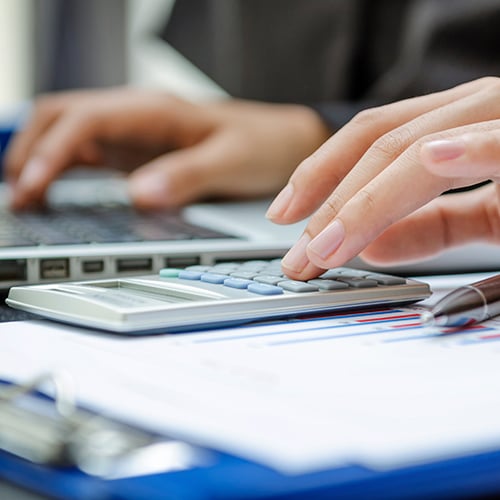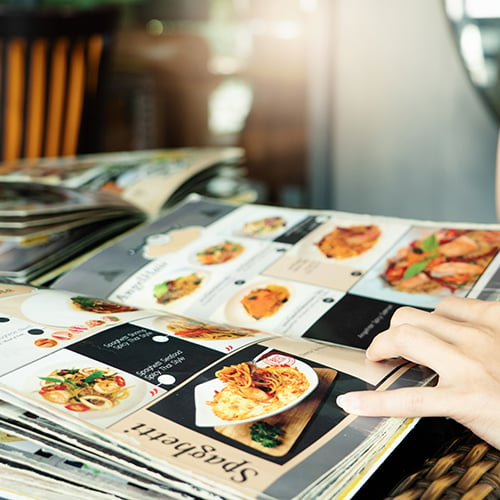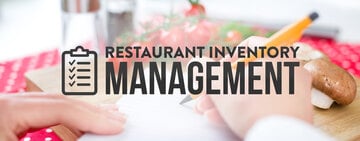
Menu pricing is the engine behind your company's success because sales are your restaurant's sole source of revenue. When creating or updating your menu, it's important to keep in mind that pricing for food directly impacts your ability to fund essential aspects of your business, including equipment, utilities, labor, and ingredients. We created this guide to help you price your menu items for maximum profit so your business continues to thrive.
Restaurant Menu Pricing Video
Watch the video below for a comprehensive breakdown of how to price a menu:
How to Price a Menu Item
To ensure that your menu items are priced for profitability without scaring customers away, you'll need to examine food cost percentages, gross profit margins, and other pricing strategies. Keep reading to find the tools you need to set appropriate menu prices.
How to Calculate Restaurant Menu Prices Based on Ideal Food Cost Percentage
Whether you’re just starting a restaurant or simply updating your menu pricing, follow the steps below to create a base price for each item according to your ideal food cost percentage.

- Choose your ideal food cost percentage. Your food cost percentage is the portion of sales spent on food. The average food cost percentage for most restaurants is in the range of 28-35%. Many restaurants aim to lower their food costs which will naturally turn more of your sales into pure profit.
- Determine the raw food cost of the menu item. For example, if you are serving a chicken Caesar salad dish, add up the total cost of the chicken, dressing, lettuce, parmesan cheese, and any other ingredients used to make the dish. Raw food cost is similar to your cost of goods sold (COGS).
- Calculate your price. Use the following equation: Price = Raw Food Cost of Item / Ideal Food Cost Percentage. You can slightly alter the price to make it a rounder or cleaner number. In the example below, you could change it to a number such as $14.50.
Example: In this example, your ideal food cost percentage is 28% and the raw food cost is $4. The complete equation looks like this: $14.29 (Price) = $4.00 (Raw Food Cost of Item) / 28% (Ideal Food Cost Percentage). The price you will use for your menu is $14.29.
Back to TopHow to Calculate Restaurant Menu Prices According to Ideal Gross Profit Margin
You can also determine menu prices using the desired gross profit margin for that item. Calculating restaurant menu prices in this way allows you to better predict and understand your bottom line. Below we show you how to use your ideal gross profit margin to come up with a menu price.

- Choose your ideal gross profit margin. Gross profit margin is a percentage that represents the profit made from your sales. A 40% gross profit margin on a dish means that a restaurant earns 40 cents on the dollar for this specific menu item. The rest goes towards the cost of the ingredients and your restaurant’s other expenses.
- Calculate your price. Use the following equation to find your price based on your desired ideal gross profit margin: Ideal Gross Profit Margin = (Menu Price - Raw Food Cost) / Menu Price
Example: Say your ideal gross profit margin is 72%, and the raw food cost is $4. Your equation would appear as follows: 72% = (Menu Price - $4) / Menu Price. The complete equation after solving for the menu price will look like the following: 72% = $14.5 - $4 / $14.50. In this example, the price you will choose for your menu is $14.50.
How to Calculate the Gross Profit Margin of Your Existing Menu Prices
If you already have your menu prices set, you can calculate the gross profit margin for each item on your menu with the same equation:
- Choose an item on your menu.
- Insert the price of the item into the equation. Gross Profit Margin = (Menu Price - Raw Cost) / Menu Price
Example: Say your menu price for a chicken Caesar salad is $14.50 and your raw food cost is $4. ($14.50 - $4) / $14.50 = 72% Gross Profit Margin. This restaurant earns 72 cents on the dollar for every Caesar salad, which is quite a high gross profit margin.
Gross Profit Margins Determine Your Bottom Line
Gross profit is an essential part of the equation that determines your net profit, otherwise known as your bottom line. The equation below shows you how to determine your net profit:
Gross Profit - (Labor Cost + Operating Costs) = Net Profit / Loss
As you can see, the greater your gross profit, the more you may have left over after deducting labor and operating costs. Therefore, it’s important to make sure you have high-profit items and to sell these items specifically.
Restaurant Pricing Strategies
You can employ a number of other tactics to boast a greater overall profit from your menu. Items with high gross profit margins and low food cost percentages will yield more money for your restaurant and help you cover your overhead costs. However, depending on your type of restaurant, your competitor's price, and the demand for the food item, you can choose a more fitting menu price. Below are 2 tactics to create the most effective menu pricing.
1. Competition Pricing Method
This method utilizes the prices of your local competition or in the general market as a baseline to consider your price. Based on your type of restaurant, you can choose from the following competition-driven methods:
- Price your item the same as your competitor’s. This is most effective if your restaurant is mainly competing based on your unique brand.
- Price your item lower than your competitor's. This is ideal if you operate a more casual restaurant or if it caters to those looking for a cost-effective alternative.
- Price your item higher than your competitor’s. If your restaurant is a high-end, upscale spot or if it attracts a demographic of diners looking for high quality, a higher price gives off the necessary impression.
2. Demand-Driven Pricing Method

Based on the demand for your restaurant and specific food options, you can potentially raise prices. If you have an enticing ambiance or if your restaurant offers unique and especially delicious food options, you can raise your prices. The demand for your business will naturally be higher because you offer food and/or an atmosphere that guests cannot get elsewhere.
For example, places like sports stadiums, amusement parks, zoos, and airports can raise their prices, since customers do not have the option of going elsewhere for food. As such, the demand is high.
Menu Prices Ultimately Depend on Your Restaurant Type
In general, your restaurant menu prices should reflect your type of restaurant and your target demographic. In this way, your prices are cohesive with your brand, formality level, and food. Guests will appreciate it if your price matches the value of your specific restaurant, and they will also be more likely to return.
Menu Psychology: How to Sell High Gross Profit Margin Items
Using menu psychology and menu engineering, you have a greater chance of selling your high gross profit margin items. Below are some tips to focus on these items, though we always recommend taking a more in-depth look at menu psychology methods.

- Draw attention to high-profit menu items. According to studies, customers are likely to order one of the first items they notice on the menu. Make sure to direct your guests’ attention to your high-profit margin items right away.
- Use graphics and colors. Guide the attention of your guests toward your high-profit items with a graphic, shaded box, or border. We recommend that you only highlight one or two items per category on your menu to avoid an overwhelming appearance.
- List profitable items first and last. In each section on your menu, place your profitable items at the top and bottom of the list. Studies show that customers usually notice the top items and the bottom items more than the middle items.
- Format the menu with the Golden Triangle. Place high-profit margin items in the center, top right, and top left corner of your menu. This is called “The Golden Triangle” by psychologists, and it refers to the area on the menu where we tend to look first.
- Use descriptive language. Entice your customers to order high-margin items by using detailed menu descriptions that explain every part of the dish.
In addition to using menu engineering and menu psychology, you can train your servers to point out certain dishes over others to persuade guests to choose those items.
Back to TopWhether you run a busy diner, casual cafe, or upscale bistro, knowing how to price a menu for a restaurant is a must-have skill. Sales are the most important factor when it comes to whether or not your business turns a profit, and shrewd restaurant menu pricing is key to success.





